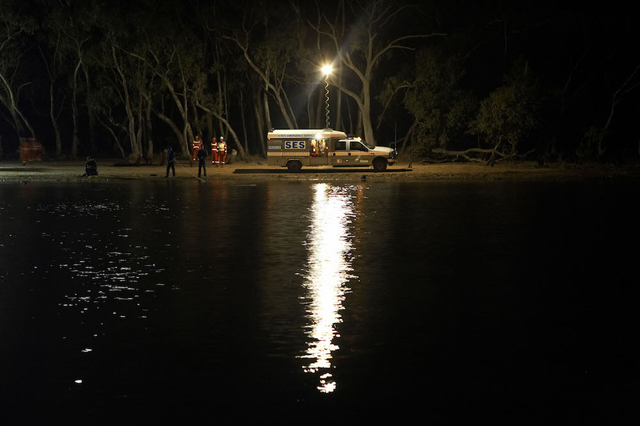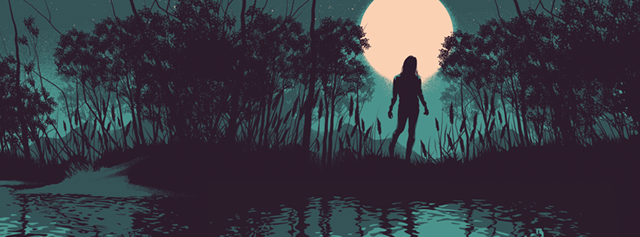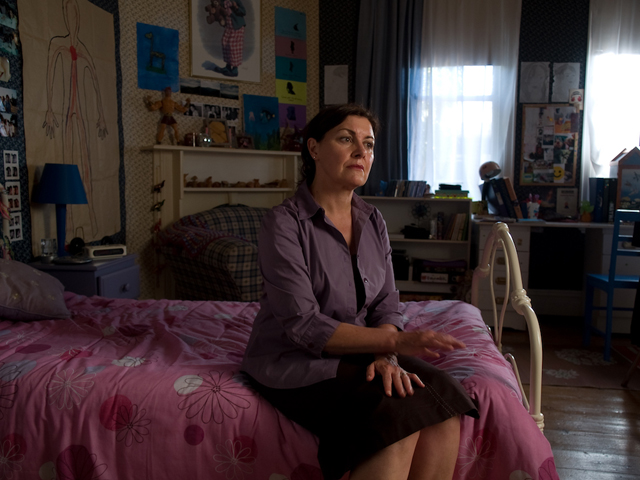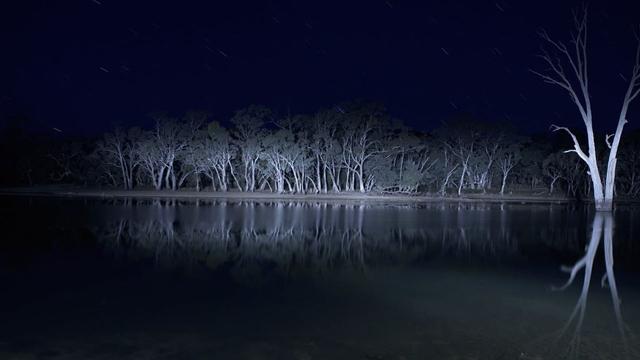 Make no mistake the announcement of Lake Mungo getting the Second Sight treatment was met by a definite rallying cry around online movie groups with everyone who had seen it before stating what an excellent film it was. Critics had similarly lauded this 2008 directorial debut Australian feature by Joel Anderson when it originally came out and there has been a very big buzz about it. It’s one of those ones I had not seen till now and that was no doubt partly due to scepticism and a general dislike of the whole (perceived) sub-genre of mockumentary / found footage movie. To put it simply I absolutely loathed The Blair Witch Project (Daniel Myrick, Eduardo Sánchez 1999) and the plethora of cheap knock offs that quickly followed on its heels and thought it really damaged the direction that horror films went on in the new Millennium, in a similar fashion to what happened with the slasher film in the wake of Wes Craven’s Scream (1996). I guess for someone who had seen it all before in shocking and vivid colour due to the Mondo movies by the likes of Jacopetti and Prosperi and of course Ruggero Deodata’s Cannibal Holocaust (1980) this sort of film was dead in the water before it had even arrived. Speaking of water and going into the experience in a sceptical fashion, what of Lake Mungo though?
Make no mistake the announcement of Lake Mungo getting the Second Sight treatment was met by a definite rallying cry around online movie groups with everyone who had seen it before stating what an excellent film it was. Critics had similarly lauded this 2008 directorial debut Australian feature by Joel Anderson when it originally came out and there has been a very big buzz about it. It’s one of those ones I had not seen till now and that was no doubt partly due to scepticism and a general dislike of the whole (perceived) sub-genre of mockumentary / found footage movie. To put it simply I absolutely loathed The Blair Witch Project (Daniel Myrick, Eduardo Sánchez 1999) and the plethora of cheap knock offs that quickly followed on its heels and thought it really damaged the direction that horror films went on in the new Millennium, in a similar fashion to what happened with the slasher film in the wake of Wes Craven’s Scream (1996). I guess for someone who had seen it all before in shocking and vivid colour due to the Mondo movies by the likes of Jacopetti and Prosperi and of course Ruggero Deodata’s Cannibal Holocaust (1980) this sort of film was dead in the water before it had even arrived. Speaking of water and going into the experience in a sceptical fashion, what of Lake Mungo though?

This is a supernatural thriller based around a tragedy befalling an atypical family unit the Palmers, mum dad, son and daughter who go to a large dam in Ararat for some fun and relaxation. Following a swim, the son Matthew comes out of the water but they realise that there is no sign of daughter Alice. Naturally this leads to panic and an awful night where family gather and friends are desperate for news and it is not long before a body (and it is a gruesome sight) is pulled from the depths. After this, strange things start happening around the Palmer home, noises, unsettling dreams and the feeling of a presence. Once cameras are set up, although Alice doesn’t live here anymore it would appear nobody thought to tell her that and her image is captured and things begin to intensify. This is the start of a build-up of mysteries that lead to secrets and lies which will deeply affect the family. A series of clues unravel which ultimately lead to the location of the film’s title, Lake Mungo a place where Alice had visited on a school trip (not actually a lake somewhat confusingly but a strange desert landscape), what are the answers that await them there?

It’s impossible to say more without big spoilers but the film is a deftly constructed tale, which lures you into its web and makes you question many things. For a start it is done well enough to keep you on edge of seat and question whether it could be based on a true story. Fair play for this convincing conceit and also for the other main favour of the film; it is genuinely spooky and scary, eerie and unsettling and is pretty assured to leave even the hardened supernatural fan feeling on edge. Perhaps it is constructed in a fashion your atypical Blumhouse horror film is although given that twist of mockumentary style, indeed there are tropes of the J-horror film and let’s face it the Japanese were the masters of putting the scare in films in the late 90’s. But for me the roots of this film spread further and I was reminded a bit of others here such as Wisconsin Death Trip (James Marsh 1999), The Poughkeepsie Tapes (John Erick Dowdle 2007) and even Andrew Jarecki’s Capturing The Friedman’s (2003) due to both style and substance. I have not mentioned the cast, they play their parts well and most of them are unknown apart from having been in mainly Australian TV dramas and as mentioned it is the first and to date only full-length film from the director. The music generally passed me by perhaps lost somewhat due to the fascination of the narrative. One thing that didn’t though was the cinematography and fantastic use of the Australian landscape, some night-time time-lapse photography being particularly memorable. Thankfully this is not a film full of jerky camera footage leaving the viewer with motion sickness but it will leave your head a bit stewed and questioning life, death and mortality. For these reasons it is a film worthy of watching and one that is likely to haunt your memory for some time after seeing it.

I guess as far as director / writer Anderson is concerned things will remain somewhat mysterious as I noted that despite an extensive amount of extras his voice is not included among them. It’s down to the aforementioned wonderful scene setting director of photography John Brawley to lead with these on the 45-minute ‘Captured Spirits’ interview and he also contributes on one of 2 commentary tracks. Originally intended to be improvised as a convincing means of making its audience feel that this was a real story, Brawley sets the scene for the development as well as finding the location with the right tone. Ararat is a real place having the suitable amenities, a feeling of being a bit run down and once found they simply began filming. Imagery and the manipulation of photography was a very important facet for the authenticity of the film and a few tricks are explained and it sounds like there was plenty of experimentation and trial and error to get the right look of things. Real news crews and even police divers were used and interviewed in character; line fluffs and mistakes were left in all to give it that true documentary and amateur filmed footage. Declaring this an neither a mockumentary or a found footage film in the true sense, or indeed a horror film, more of a supernatural thriller, Brawley goes on to cite films that they looked at as influential which pleased me as one I had mentioned was included along with the work of David Lynch and naturally Nic Roeg’s Don’t Look Now. An interesting and in-depth feature on an “unconventional filming methodology.” Producer David Rapsey gets a much shorter segment. Considering he wanted a much higher budget than the director anticipated he sounds like a perfect contributor to the project. However, an “agonising” insistence on 23 edits before he was happy means he wanted things perfect on release. A USA based TV series is currently being negotiated. There are many incidental characters in the film and 2 of these Carole Patullo (a cop) and James Lawson (a friend) have a sit-down chat telling us the parts they played in the process and ending the interview section.

It’s to the film makers and writers we turn to for their opinions next. Justin Benson and Aaron Moorhead seem the perfect choice. Having seen a few of their films and although being somewhat underwhelmed, Lake Mungo seems consistent in many ways with their oeuvre of mystery. They applaud it on being genuinely scary when so few films actually are these days and for the style it seems so real and like an actual crime documentary. They raise many interesting points as well as discussing plenty of other films including the whole Cannibal Holocaust / Blair Witch scenario. Is this a cult classic that is only just starting to gain notoriety and serious appreciation? If that’s the case the limited edition will no doubt be selling out very quickly. Rob Savage known it would seem largely for Host (2020) which I have heard of but not seen is next. He makes a lot of similar points saying he found the film by searching for really scary horror haunting films via lists and also uses terminology such as “magic tricks” describing the way it reels its audience in and seems so convincing. “It’s a movie that makes you lean in and scrutinise every corner of the screen” I expect you will be looking in every corner of your house after watching before you go to bed too. Josh Nelson has extensive credits as both writer and director in the short film medium. He presents a video essay based around Anderson’s description of his film as “simulacra and spirits” tracing roots back to ancient philosophy and beyond. We are taken on a short tour through the empty rooms of the house itself and finally there are 13 minutes of deleted scenes, a couple of which are particularly intriguing and make you wonder if they will have added to perception of the film if left in.

Plenty to wade through but intrinsically Lake Mungo remains a bit of an enigma. It is certainly a talented and to a large extent a unique filmic experience, whether its origins were meant to be or whether it came out the way it did accidently is a question we are left with. The biggest mystery is that of the absent director, why did he not take part here and contribute to this extensive edition of his only film and why did he not go on to make more? It’s almost as though he has disappeared into simulacra and spirits, or the bottom of a very large dam himself. I am not convinced just how convincing the film itself is either, although there is no denying how many were taken in by its construct. Ultimately Lake Mungo exploits its audience via manipulation and this could always lead to the danger of said viewership leaving the experience feeling cheated. Then again isn’t that what it is all about, cinema is after all a box of magic tricks designed to do just that?
Pete Woods
https://www.facebook.com/SecondSightFilms
Lake Mungo Limited Edition: Pre-Order Available 7th June 2021

Leave a Reply